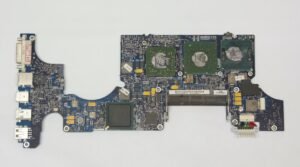Tesla Model X and S Difference
The Tesla Model X and Model S are both incredible electric vehicles with cutting-edge technology and impressive performance. While they share many similarities, there are also significant differences between these two models. Understanding these differences can help you make an informed decision when choosing the right Tesla for your needs.
Key Takeaways:
- Both the Model X and Model S are fully electric vehicles manufactured by Tesla.
- The Model X is an SUV, while the Model S is a sedan.
- The Model X has a higher seating capacity compared to the Model S.
- The Model S offers a longer range than the Model X.
- Both models feature Tesla’s Autopilot system for enhanced driving assistance.
Design and Seating
The **Model X** is an SUV designed with versatility and practicality in mind. It features Falcon Wing doors that provide easy access to the rear seats, offering a unique and futuristic look. The vehicle can comfortably accommodate up to **seven passengers** with three rows of seats. Additionally, the **Model X** has a spacious cargo area, making it suitable for family trips or hauling larger items. On the other hand, the **Model S** is a sleek and sporty sedan that seats up to **five passengers**. Its design focuses on aerodynamics and performance, offering a more streamlined driving experience with a slightly smaller cargo space.
Performance and Range
The **Model X** and **Model S** both deliver impressive performance thanks to their electric drivetrains. The **Model X** SUV is available in different configurations, including the powerful **Performance** variant which can accelerate from 0 to 60 mph in just **2.6 seconds**. It offers excellent traction and stability with its dual-motor all-wheel drive system. As for the **Model S**, it is known for its incredible acceleration and speed. The top-of-the-line **Model S** **Plaid** variant can achieve a mind-blowing 0-60 mph time in only **1.99 seconds**, making it one of the fastest production cars in the world. However, the **Model S** also offers a longer range compared to the **Model X**, allowing for more extended journeys between charges.
Notable Features
Both **Tesla** vehicles come packed with innovative features and advanced technologies. These include:
- Tesla’s Autopilot system for enhanced driving assistance and safety.
- Large touchscreen displays for intuitive and interactive control of vehicle settings.
- Over-the-air software updates that continuously enhance the driving experience.
- Access to Tesla’s Supercharger network for fast charging on long trips.
- Premium audio systems for an immersive sound experience.
| Category | Model X | Model S |
|---|---|---|
| Seating Capacity | 7 passengers | 5 passengers |
| Range (EPA est.) | Up to 351 miles | Up to 412 miles |
| Acceleration (0-60 mph) | 2.6 seconds (Performance) | 1.99 seconds (Plaid) |
Conclusion
In conclusion, while both the Tesla Model X and Model S offer exceptional electric driving experiences, they cater to different needs and preferences. The Model X is perfect for those who prioritize spaciousness and versatility with its SUV design and higher seating capacity. On the other hand, the Model S appeals to individuals seeking a high-performance sedan with impressive acceleration and longer range capabilities. Whichever model you choose, owning a Tesla guarantees an environmentally-friendly and technologically advanced driving experience.

Common Misconceptions
Performance Differences
One common misconception people have about the Tesla Model X and Model S is that the Model X is significantly slower in terms of performance compared to the Model S. However, this is not entirely true. While the Model S is known for its impressive acceleration, the Model X also offers impressive performance capabilities.
- Both models offer similar acceleration times, especially in their higher-end versions
- The Model X has the advantage of being an SUV, providing more space and utility
- Model X can even outperform the Model S in some off-road situations due to its all-wheel drive and higher ground clearance
Interior Space and Comfort
Another common misconception is that the Tesla Model S has more interior space and comfort compared to the Model X. However, this is not entirely accurate as the Model X actually provides a more spacious and versatile interior.
- The Model X offers seating for up to seven passengers, while the Model S can only accommodate up to five
- Model X features innovative Falcon Wing doors, making it easier to access the rear seats and providing a unique experience
- The Model X also has more headroom and legroom in both the front and rear seats, providing a more comfortable experience for occupants
Weight and Fuel Efficiency
There is a misconception that the Tesla Model S is lighter and more fuel-efficient compared to the Model X. However, this is not entirely true as the Model X is designed to be an electric SUV, which naturally results in a slightly higher weight and lower fuel efficiency compared to the sedan-like Model S.
- The Model X’s greater weight is due to its larger size and extra features like the Falcon Wing doors
- Despite the weight difference, both vehicles achieve impressive fuel efficiency thanks to the electric powertrain
- While the Model S may have a slight edge in terms of efficiency due to its streamlined design, the difference is minimal
Price
A common misconception is that the Tesla Model X is significantly more expensive than the Model S. However, the price difference is not as substantial as some people believe.
- When comparing the base models of both vehicles, the Model X is only marginally more expensive
- Pricing for both models varies greatly depending on the chosen configurations and optional features
- While the Model X tends to have a higher starting price, it also offers more standard features and amenities compared to the Model S
Charging Infrastructure Compatibility
There is a misconception that the Tesla Model X and Model S have different compatibility with Tesla’s Supercharger network and other charging infrastructure. However, both models are fully compatible with the same charging network.
- Both the Model X and Model S can utilize Tesla Superchargers, providing fast and convenient charging
- Both models are also compatible with other public charging stations that support the common electric vehicle charging standards
- There is no difference in charging capabilities or infrastructure compatibility between the two models

Introduction
The Tesla Model X and Model S are two luxury electric vehicles produced by Tesla Motors. While they share some similarities, they also have distinctive features that set them apart. In this article, we explore various aspects of both models to understand the differences between them.
Battery Range Comparison
One crucial factor to consider when comparing electric vehicles is their battery range. Here, we present the maximum estimated battery range for both the Model X and Model S.
| Model | Battery Range (miles) |
|---|---|
| Model X | 351 |
| Model S | 373 |
Acceleration Comparison
Another key aspect when looking at performance is the acceleration of the vehicles. The table below highlights the 0-60 mph acceleration time for both models.
| Model | 0-60 mph Acceleration (seconds) |
|---|---|
| Model X | 4.4 |
| Model S | 3.1 |
Top Speed Comparison
If top speed is a priority for you, take a look at the maximum achievable speeds for the Model X and Model S as displayed below.
| Model | Top Speed (mph) |
|---|---|
| Model X | 155 |
| Model S | 163 |
Interior Space Comparison
Interior space plays a significant role in choosing a luxury vehicle. Consider the passenger and cargo capacity differences between the Model X and Model S.
| Model | Passenger Capacity | Cargo Capacity (cubic feet) |
|---|---|---|
| Model X | Up to 7 | 88 |
| Model S | Up to 5 | 28.4 |
Price Comparison
A significant consideration when buying a vehicle is its price. The table below shows the starting prices for both the Model X and Model S.
| Model | Starting Price ($) |
|---|---|
| Model X | 79,990 |
| Model S | 69,420 |
Charging Speed Comparison
Charging speed is an essential factor to consider for electric vehicles. Let’s compare the average miles of range gained per hour when charging both the Model X and Model S.
| Model | Average Charging Speed (miles per hour) |
|---|---|
| Model X | 51 |
| Model S | 44 |
Safety Features Comparison
Ensuring safety is unquestionably a priority for any vehicle. Here, we outline some advanced safety features present in both the Model X and Model S.
| Model | Safety Features |
|---|---|
| Model X |
– Forward Collision Warning – Lane Departure Avoidance – Automatic Emergency Braking |
| Model S |
– Automatic Emergency Braking – Blind Spot Detection – Collision Avoidance Assist |
Exterior Design Comparison
The exterior design contributes to the overall appeal of a vehicle. Take a look at the distinctive design elements for both the Model X and Model S.
| Model | Exterior Design Features |
|---|---|
| Model X |
– Falcon Wing Doors – Panoramic Windshield – Streamlined Shape |
| Model S |
– Sleek and Sporty Profile – Panoramic Roof – Aerodynamic Silhouette |
Infotainment System Comparison
Modern vehicles offer advanced infotainment systems for a seamless driving experience. Here are some of the notable features in the Model X and Model S.
| Model | Infotainment System Features |
|---|---|
| Model X |
– 17-inch Touchscreen Display – Premium Audio System – Navigation with Real-Time Traffic Updates |
| Model S |
– 17-inch Touchscreen Display – Ultra High Fidelity Sound – Internet Connectivity |
Conclusion
When comparing the Tesla Model X and Model S, it becomes evident that both models offer impressive electric performance, advanced features, and luxurious comfort. The Model X excels in terms of interior space, seating capacity, and cargo capacity. On the other hand, the Model S boasts superior acceleration, top speed, and a slightly longer battery range. The decision ultimately comes down to individual preferences, whether it’s prioritizing passenger capacity, speed, or other factors. Regardless of choice, both vehicles showcase Tesla’s commitment to sustainable, high-performance electric cars.
Frequently Asked Questions
What are the major differences between the Tesla Model X and Tesla Model S?
The Tesla Model X is an SUV, while the Model S is a sedan. The Model X has falcon-wing doors and a third-row seating option, making it more suitable for larger families. The Model S is a sleeker vehicle that focuses on performance with a lower profile and faster acceleration.
How does the interior of the Tesla Model X differ from the Model S?
The Tesla Model X has a more spacious interior due to its SUV design, providing seating for up to seven passengers with the optional third-row seat. The Model S, being a sedan, offers seating for up to five passengers. Both models feature Tesla’s minimalist interior design and a large touchscreen display.
What is the range difference between the Tesla Model X and Model S?
The range of Tesla Model X varies based on the specific variant, but it generally offers a slightly lower range compared to the Model S. However, both vehicles have impressive ranges, with the Model X capable of covering over 300 miles per charge and the Model S exceeding 400 miles in some configurations.
How does the performance of the Model X differ from the Model S?
While both the Model X and Model S offer impressive performance, the Model S is usually considered the faster and more sporty option. The Model S has various performance options, including the high-performance ‘Plaid’ version capable of blistering acceleration. The Model X, while still quick, prioritizes utility and passenger comfort over sheer speed.
Do the Tesla Model X and Model S have different charging capabilities?
The charging capabilities of the Tesla Model X and Model S are similar. Both models come with Tesla’s Supercharger network access, allowing for convenient and fast charging at Supercharger stations. Additionally, they are compatible with public Level 2 charging stations and can be charged using a standard household outlet with an adapter.
What are the cargo capacity differences between the Tesla Model X and Model S?
Due to its SUV design, the Tesla Model X generally offers more cargo space than the Model S. The Model X has a large rear cargo area, and the 60/40 split-folding second-row seats provide additional flexibility. The Model S, being a sedan, has a smaller trunk but still offers ample storage for everyday needs.
Are there any notable safety differences between the Tesla Model X and Model S?
Both the Tesla Model X and Model S come with a comprehensive set of safety features and have received high safety ratings. However, the Model X has a unique feature with its falcon-wing doors offering easier access to rear seats in tight parking spots. Additionally, the Model X’s higher seating position provides improved visibility on the road.
Which model is more suitable for long-distance travel?
Both the Tesla Model X and Model S are excellent choices for long-distance travel due to their extensive range capabilities and access to Tesla’s Supercharger network. However, the Model S, being a sedan, may offer a slightly smoother and more aerodynamic experience at high speeds, while the Model X provides the advantage of additional space and seating options.
What are some other notable differences between the Tesla Model X and Model S?
Apart from the major differences mentioned earlier, the Tesla Model X has falcon-wing doors that provide a unique opening mechanism, making it easier to enter and exit the vehicle, especially in tight spaces. The Model S, on the other hand, has a sleeker design with a panoramic glass roof option, allowing for an open and airy feel inside the cabin.
Do the Tesla Model X and Model S have the same autopilot features?
Both the Tesla Model X and Model S come equipped with Tesla’s advanced Autopilot system, offering a range of driver-assistance features such as active cruise control, lane-keeping assist, and self-parking capabilities. However, specific features and software updates may vary between different model years and versions of each vehicle.




